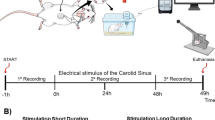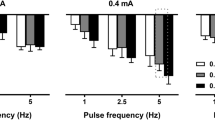Abstract
Reflex summation in the expression of left and right aortic baroreflex control of hemodynamic functions was investigated. In anesthetized Sprague–Dawley rats, mean arterial pressure (MAP), heart rate (HR), and mesenteric vascular resistance (MVR) were recorded following left, right, and bilateral stimulation of the aortic depressor nerve (ADN). Stimulation frequency was varied between low (1 Hz), moderate (5 Hz), and high (20 Hz). At 1 Hz, left and right ADN stimulation evoked similar depressor, bradycardic and MVR responses, whereas bilateral stimulation induced larger MAP, HR, and MVR reductions compared with stimulations of either side. The sum of the separate and combined stimulation effects on MAP, HR, and MVR was similar, indicating an additive summation. A similar additive summation was observed with HR responses at 5 and 20 Hz. Left-sided and bilateral stimulation produced greater depressor and MVR responses than right-sided stimulation, with responses of the bilateral stimulation mimicking those of the left side. The bilateral MAP or MVR response was smaller than the sum of the separate responses, suggesting an inhibitory summation. In conclusion, reflex summation of the left and right aortic baroreceptor afferent input is differentially expressed in relation to the frequency of the input signal. Summation of baroreflex control of HR is always additive and independent of stimulation frequency. Summation of baroreflex control of MAP is additive when the frequency input is small and inhibitory when the frequency input is moderate to high, with MAP changes mainly driven by parallel baroreflex-triggered changes in vascular resistance.





Similar content being viewed by others
Data availability
Data available on request from the author.
Change history
27 May 2023
A Correction to this paper has been published: https://doi.org/10.1007/s00424-023-02823-x
References
Abboud FM, Thames MD (1983) Interaction of cardiovascular reflexes in circulatory control. In: Handbook of Physiology, vol 3. Am Physiol Soc, Bethesda, MD, pp 675–753. https://doi.org/10.1002/cphy.cp020319
Barringer DL, Buñag RD (1990) Differential anesthetic depression of chronotropic baroreflexes in rats. J Cardiovasc Pharmacol 15:10–15. https://doi.org/10.1097/00005344-199001000-00002
Cheung Y-f (2010) Chapter 6 - systemic circulation. In: Anderson RH, Baker EJ, Penny DJ et al. (eds) Paediatric Cardiology (Third Edition). Churchill Livingstone, Philadelphia, pp 91–116. https://doi.org/10.1016/B978-0-7020-3064-2.00006-0
Christensen KL, Mulvany MJ (1993) Mesenteric arcade arteries contribute substantially to vascular resistance in conscious rats. J Vasc Res 30:73–79. https://doi.org/10.1159/000158978
de Leeuw PW, Bisognano JD, Bakris GL, Nadim MK, Haller H, Kroon AA (2017) Sustained reduction of blood pressure with baroreceptor activation therapy: results of the 6-year open follow-up. Hypertension 69:836–843. https://doi.org/10.1161/HYPERTENSIONAHA.117.09086
de Paula PM, Castania JA, Bonagamba LG, Salgado HC, Machado BH (1999) Hemodynamic responses to electrical stimulation of the aortic depressor nerve in awake rats. Am J Physiol 277:R31–R38. https://doi.org/10.1152/ajpregu.1999.277.1.R31
Domingos-Souza G, Santos-Almeida FM, Meschiari CA, Ferreira NS, Pereira CA, Pestana-Oliveira N, Prates-Costa TC, Tostes RC, White C, Fazan R Jr (2021) The ability of baroreflex activation to improve blood pressure and resistance vessel function in spontaneously hypertensive rats is dependent on stimulation parameters. Hypertens Res : Off J Jpn Soc Hypertens 44:932–940. https://doi.org/10.1038/s41440-021-00639-9
Durand Mde T, Castania JA, Fazan R Jr, Salgado MC, Salgado HC (2011) Hemodynamic responses to aortic depressor nerve stimulation in conscious L-NAME-induced hypertensive rats. Am J Physiol Regul Integr Comp Physiol 300:R418–R427. https://doi.org/10.1152/ajpregu.00463.2010
Durand MT, Mota AL, Barale AR, Castania JA, Fazan R Jr, Salgado HC (2012) Time course of the hemodynamic responses to aortic depressor nerve stimulation in conscious spontaneously hypertensive rats. Braz J Med Biol Res = Rev Bras Pesquisas Med Biol / Soc Bras Biofisica [et al] 45:444–449. https://doi.org/10.1590/s0100-879x2012007500032
Fan W, Andresen MC (1998) Differential frequency-dependent reflex integration of myelinated and nonmyelinated rat aortic baroreceptors. Am J Physiol 275:H632–H640. https://doi.org/10.1152/ajpheart.1998.275.2.H632
Fan W, Schild JH, Andresen MC (1999) Graded and dynamic reflex summation of myelinated and unmyelinated rat aortic baroreceptors. Am J Physiol 277:R748–R756. https://doi.org/10.1152/ajpregu.1999.277.3.R748
Hainsworth R, Ledsome JR, Carswell F (1970) Reflex responses from aortic baroreceptors. Am J Physiol 218:423–429. https://doi.org/10.1152/ajplegacy.1970.218.2.423
Heusser K, Tank J, Brinkmann J, Schroeder C, May M, Großhennig A, Wenzel D, Diedrich A, Sweep FC, Mehling H, Luft FC, Jordan J (2016) Preserved autonomic cardiovascular regulation with cardiac pacemaker inhibition: a crossover trial using high-fidelity cardiovascular phenotyping. J Am Heart Assoc 5:e002674. https://doi.org/10.1161/jaha.115.002674
Huber DA, Schreihofer AM (2010) Attenuated baroreflex control of sympathetic nerve activity in obese Zucker rats by central mechanisms. J Physiol 588:1515–1525. https://doi.org/10.1113/jphysiol.2009.186387
Ishikawa N, Sagawa K (1983) Nonlinear summation of depressor effects of carotid sinus pressure changes and aortic nerve stimulation in the rabbit. Circ Res 52:401–410. https://doi.org/10.1161/01.res.52.4.401
Kawada T, Ikeda Y, Sugimachi M, Shishido T, Kawaguchi O, Yamazaki T, Alexander J, Jr., Sunagawa K (1996) Bidirectional augmentation of heart rate regulation by autonomic nervous system in rabbits. Am J Physiol 271:H288–H295. https://doi.org/10.1152/ajpheart.1996.271.1.H288
Kendrick JE, Matson GL, Lalley PM (1979) Central interaction between the baroreceptor reflexes from the carotid sinus and aortic arch. Am J Physiol 236:H127–133. https://doi.org/10.1152/ajpheart.1979.236.1.H127
Koch E (1931) Die reflektorische selbststeuerung des kreislaufes. Ergebnisse der Kreislaufforschung, vol 1. Dresden [u.a.]: Steinkopff, pp 1890–1965
Kunze DL (1972) Reflex discharge patterns of cardiac vagal efferent fibres. J Physiol 222:1–15. https://doi.org/10.1113/jphysiol.1972.sp009784
Ma X, Abboud FM, Chapleau MW (2002) Analysis of afferent, central, and efferent components of the baroreceptor reflex in mice. Am J Physiol Regul Integr Comp Physiol 283:R1033–R1040. https://doi.org/10.1152/ajpregu.00768.2001
Moon EA, Goodchild AK, Pilowsky PM (2002) Lateralisation of projections from the rostral ventrolateral medulla to sympathetic preganglionic neurons in the rat. Brain Res 929:181–190. https://doi.org/10.1016/S0006-8993(01)03388-1
Pinto TO, Lataro RM, Castania JA, Durand MT, Silva CA, Patel KP, Fazan R Jr, Salgado HC (2016) Electrical stimulation of the aortic depressor nerve in conscious rats overcomes the attenuation of the baroreflex in chronic heart failure. Am J Physiol Regul Integr Comp Physiol 310:R612–R618. https://doi.org/10.1152/ajpregu.00392.2015
Possas OS, Johnson AK, Lewis SJ (2006) Role of nitrosyl factors in the hindlimb vasodilation elicited by baroreceptor afferent nerve stimulation. Am J Physiol Regul Integr Comp Physiol 290:R741–R748. https://doi.org/10.1152/ajpregu.00660.2005
Rowell LB, Detry JM, Blackmon JR, Wyss C (1972) Importance of the splanchnic vascular bed in human blood pressure regulation. J Appl Physiol 32:213–220. https://doi.org/10.1152/jappl.1972.32.2.213
Salgado HC, Barale ÁR, Castania JA, Machado BH, Chapleau MW, Fazan R (2007) Baroreflex responses to electrical stimulation of aortic depressor nerve in conscious SHR. Am J Physiol Heart Circ Physiol 292:H593–600. https://doi.org/10.1152/ajpheart.00181.2006
Salman IM (2016) Major autonomic neuroregulatory pathways underlying short- and long-term control of cardiovascular function. Curr Hypertens Rep 18:016–0625. https://doi.org/10.1007/s11906-016-0625-x
Salman IM, Ameer OZ, McMurray S, Giarola AS, Sridhar A, Lewis SJ, Hsieh YH (2020) Laterality influences central integration of baroreceptor afferent input in male and female Sprague Dawley rats. Front Physiol 11:499. https://doi.org/10.3389/fphys.2020.00499
Salman IM, Ameer OZ, McMurray S, Hassan SF, Sridhar A, Lewis SJ, Hsieh YH (2022) Low intensity stimulation of aortic baroreceptor afferent fibers as a potential therapeutic alternative for hypertension treatment. Sci Rep 12:12242. https://doi.org/10.1038/s41598-022-15761-y
Salman IM, Ameer OZ, McMurray S, Hassan SF, Sridhar A, Lewis SJ, Hsieh YH (2023) Differential central integration of left versus right baroreceptor afferent input in spontaneously hypertensive rats. J Hypertens 20:0000000000003448
Salman IM, Hildreth CM, Ameer OZ, Phillips JK (2014) Differential contribution of afferent and central pathways to the development of baroreflex dysfunction in chronic kidney disease. Hypertension 63:804–810. https://doi.org/10.1161/hypertensionaha.113.02110
Salman IM, Phillips JK, Ameer OZ, Hildreth CM (2015) Abnormal central control underlies impaired baroreflex control of heart rate and sympathetic nerve activity in female Lewis Polycystic Kidney rats. J Hypertens 33:1418–1428. https://doi.org/10.1097/hjh.0000000000000572
Sapru HN, Krieger AJ (1977) Carotid and aortic chemoreceptor function in the rat. J Appl Physiol 42:344–348. https://doi.org/10.1152/jappl.1977.42.3.344
Schwartz CE, Stewart JM (2012) The arterial baroreflex resets with orthostasis. Front Physiol 3:461. https://doi.org/10.3389/fphys.2012.00461
Yamazaki T, Sagawa K (1989) Summation of sinoaortic baroreflexes depends on size of input signals. Am J Physiol 257:H465–H472. https://doi.org/10.1152/ajpheart.1989.257.2.H465
Zile MR, Lindenfeld J, Weaver FA, Zannad F, Galle E, Rogers T, Abraham WT (2020) Baroreflex activation therapy in patients with heart failure with reduced ejection fraction. J Am Coll Cardiol 76:1–13. https://doi.org/10.1016/j.jacc.2020.05.015
Acknowledgements
The author would like to thank the research facility of the School of Medicine of Case Western Reserve University (Cleveland, OH, USA) where this work was undertaken. The author would also like to thank Ms Melissa Dusek and Dr Paulina Getsy (Case Western Reserve University) for their excellent technical assistance. The author extends special thanks to Dr Yee-Hsee Hsieh and Professor Stephen Lewis from Case Western Reserve University and Dr Arun Sridhar and Dr Sheridan McMurray from Galvani Bioelectronics (Stevenage, Hertfordshire, UK) for their exceptional and generous research support.
Funding
The study was supported by Galvani Bioelectronics-GlaxoSmithKline (Grant number: GGSK-1004).
Author information
Authors and Affiliations
Contributions
IS contributed to design of research, carried out experiments, analyzed data, interpreted results of experiments, prepared figures, drafted manuscript, and approved and submitted final version of manuscript.
Corresponding author
Ethics declarations
Ethics approval
All procedures were conducted in accordance with the National Institutes of Health Guide for the Care and Use of Laboratory Animals and approved by the Animal Care and Use Committee of Case Western Reserve University, Cleveland, OH, USA.
Competing interests
The author declares no competing interests.
Additional information
Publisher's note
Springer Nature remains neutral with regard to jurisdictional claims in published maps and institutional affiliations.
The original online version of this article was revised: The original article contains an error during online publication. The color of the bars labelled Bi and Sum on panel (B) of Figures 2 and 4 were incorrectly captured. This has been updated now.
Rights and permissions
Springer Nature or its licensor (e.g. a society or other partner) holds exclusive rights to this article under a publishing agreement with the author(s) or other rightsholder(s); author self-archiving of the accepted manuscript version of this article is solely governed by the terms of such publishing agreement and applicable law.
About this article
Cite this article
Salman, I.M. Differential frequency-dependent reflex summation of the aortic baroreceptor afferent input. Pflugers Arch - Eur J Physiol 475, 933–944 (2023). https://doi.org/10.1007/s00424-023-02820-0
Received:
Revised:
Accepted:
Published:
Issue Date:
DOI: https://doi.org/10.1007/s00424-023-02820-0




